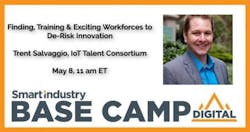Base Camp Digital Preview: Finding & exciting talent to realize your transformation
Trent Salvaggio knows how to build teams to implement digital transformation. He’ll share strategies during his presentation at Base Camp Digital during his presentation "Finding, Training & Exciting Workforces to De-Risk Innovation."
We wanted a sneak peak, so we asked the executive director of the IoT Talent Consortium a few questions. Take a look…
Smart Industry: Is the digital skills gap still a problem?
Trent: The originally conceived digital skills gap is still a problem in that organizations are struggling to find the talent necessary to fully execute on their digital initiatives. The reason this continues to exist is a multifaceted one. While once thought of as a purely “supply side” issue, we now understand that even those individuals equipped with the skills necessary for the jobs of tomorrow are simply not attracted to the existing job roles/positions offered by many employers. Sadly, this gap seems to be increasing as tens of thousands of advanced-manufacturing and cybersecurity jobs remain unfilled.
Smart Industry: Is the solution more in finding talent or equipping existing personnel to adopt new skills/tools?
Trent: I wish I could say that it was as simple as either of these, but it is not. Our experience suggests that a sustainable solution consists of:
- A robust and continual reskilling program driven and supported by the employer.
- The collaborative development of an adaptive ecosystem capable of producing new talent with the skills required for today’s challenges.
- A leadership team capable of providing a culture focused on continuous learning, innovation, autonomy, and embracing creativity and change.
Smart Industry: Provide a recent example of industry and academia partnering to address this problem.
Trent: I can think of no better example than what is currently happening at the University of Wisconsin–Milwaukee’s Connected Systems Institute. Taking a multidisciplinary approach, CSI is creating collaborations between academic scholars and industry experts from the most forward-looking commercial organizations to create a learning experience that allows their graduates to enter the workforce with not only the technical skills required for success, but also the associated interpersonal and problem-solving skills necessary to thrive in an ever-changing work environment.
Like any great partnership, there is a lot of effort required to bring these (sometimes) disparate entities together. However, if we can learn anything from the work that is happening in many leading educational institutions, it is that these collaborations have the potential to radically change the way we traditionally have thought about higher education.
Smart Industry: How can manufacturers appeal to a younger, digitally inclined workforce?
Trent: All indicators seem to suggest this is something that requires somewhat of a top-down approach throughout all levels of leadership within an organization. The most effective organizations have been able to attract the best talent by “meeting them where they are.” This does not mean only where they are physically, but where they are in terms of their values, ideas and desires both inside and outside the workplace. The great generational shift occurring in the workforce with the exit of the Baby Boomers and the prominent entrance of Millennials (nearly 50% of the workforce in 2020 will be millennials) requires leaders reframing their existing thoughts on the traditional employment relationship to align with the new norms of the incoming workforce.
If there is one thing that we know for certain about Industry 4.0, it is that it will be driven by human ingenuity and those organizations that are best able to leverage their expertise.


